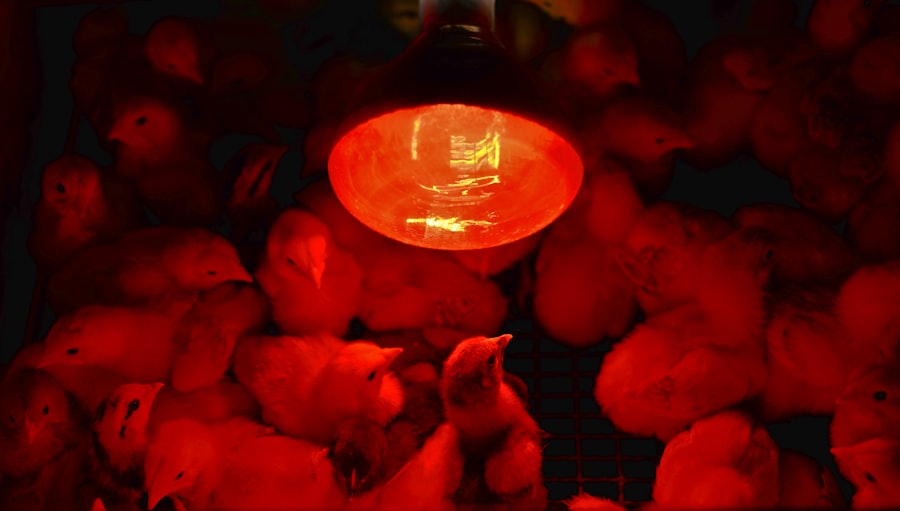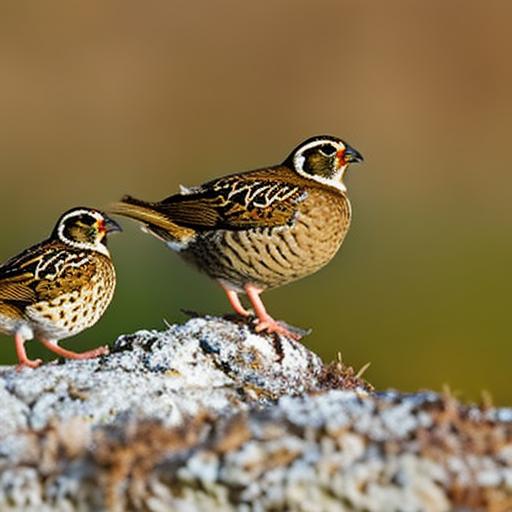Brood light is an essential component in the successful rearing of quail. The primary purpose of brood light is to provide a source of warmth and light for newly hatched quail chicks. This is crucial for their survival and development during the early stages of life. The brood light serves as a surrogate for the warmth and light that the chicks would have received from their mother in a natural setting. It helps to regulate their body temperature, encourages healthy growth, and stimulates natural behaviors such as feeding and drinking. Additionally, brood light helps to reduce stress and anxiety in the chicks, creating a more comfortable and conducive environment for their overall well-being. Without the proper brood light, quail chicks are at risk of developing health issues, stunted growth, and even mortality.
Furthermore, brood light also plays a role in establishing a day-night cycle for the quail chicks. This is important for their circadian rhythm and overall development. By providing a consistent light source, it helps to regulate their sleep patterns and encourages natural behaviors. This is particularly important as quail are known to be sensitive to changes in light and can become stressed or disoriented without a proper day-night cycle. Overall, the purpose of brood light for quail is to mimic the natural conditions that they would experience in the wild, providing them with the necessary warmth, light, and environmental cues for healthy growth and development.
Key Takeaways
- Brood light is used to mimic natural daylight and encourage healthy growth and development in quail chicks.
- The ideal duration for brood light exposure is typically 24 hours a day for the first week, followed by gradually decreasing the duration as the quail grow older.
- Factors to consider when deciding how long to keep quail under brood light include their age, behavior, and environmental conditions.
- It is important to monitor quail behavior and development under brood light to ensure they are thriving and not experiencing any negative effects.
- Gradually transitioning quail away from brood light involves reducing the duration of light exposure over time to prepare them for natural lighting conditions.
- Prolonged brood light exposure can lead to negative health effects in quail, such as reduced activity and increased stress.
- Seeking professional advice, such as from a veterinarian or experienced quail breeder, can help determine the appropriate brood light duration for quail based on individual circumstances.
Determining the Ideal Duration for Brood Light Exposure
When determining the ideal duration for brood light exposure, it is important to consider the specific needs of quail chicks at different stages of development. In general, quail chicks require brood light for the first few weeks of life to ensure proper growth and development. During this time, they are particularly vulnerable and dependent on the warmth and light provided by the brood light. As they grow older, their need for brood light diminishes as they become more independent and resilient.
The ideal duration for brood light exposure can vary depending on factors such as the breed of quail, ambient temperature, and the availability of natural light. In general, quail chicks should be provided with brood light for approximately 4-6 weeks. During this time, they will gradually acclimate to their environment and develop the ability to regulate their body temperature without the need for artificial heat sources. It is important to monitor the behavior and development of the quail chicks during this period to ensure that they are thriving and ready to transition away from brood light.
It is also important to consider the gradual reduction of brood light exposure as the quail chicks mature. This can help them adjust to natural light cycles and prepare them for life outside of the brooder. By gradually reducing the duration of brood light exposure, quail chicks can develop a natural tolerance to varying light conditions and become better equipped to thrive in their adult environment.
Factors to Consider When Deciding How Long to Keep Quail Under Brood Light
When deciding how long to keep quail under brood light, there are several factors that should be taken into consideration. Firstly, the breed of quail plays a significant role in determining their specific needs for brood light exposure. Different breeds may have varying levels of tolerance to temperature fluctuations and light conditions, which can impact their requirements for brood light.
Additionally, ambient temperature is an important factor to consider when determining the duration of brood light exposure. Quail chicks require a consistent source of warmth to maintain their body temperature during the early stages of life. If the ambient temperature is too low, they may require extended exposure to brood light to compensate for the lack of natural warmth.
Furthermore, the availability of natural light should be taken into account when deciding how long to keep quail under brood light. If quail chicks have access to natural sunlight or are being raised in an environment with adequate natural lighting, their reliance on brood light may be reduced. In such cases, it may be possible to gradually reduce the duration of brood light exposure as they acclimate to natural light cycles.
It is also important to consider the behavior and development of the quail chicks when determining how long to keep them under brood light. Monitoring their activity, feeding patterns, and overall well-being can provide valuable insights into their readiness to transition away from brood light. By taking these factors into consideration, it is possible to determine the optimal duration of brood light exposure for quail chicks.
Monitoring Quail Behavior and Development Under Brood Light
Monitoring the behavior and development of quail chicks under brood light is essential for ensuring their well-being and readiness to transition away from artificial heat sources. By observing their activity, feeding patterns, and overall growth, it is possible to assess their progress and determine when they are ready to thrive without the reliance on brood light.
Quail chicks that are thriving under brood light will exhibit active behavior, including feeding, drinking, and exploring their environment. They will demonstrate healthy growth and development, with steady weight gain and strong, coordinated movements. Additionally, they will display natural behaviors such as preening, dust bathing, and socializing with other chicks. These are all positive indicators that they are adapting well to their environment and are ready to transition away from brood light.
On the other hand, quail chicks that are not thriving under brood light may exhibit signs of distress or discomfort. This can include huddling together for warmth, excessive vocalization, lethargy, or reduced appetite. These behaviors may indicate that they are not receiving adequate warmth or are experiencing stress due to environmental factors. In such cases, it may be necessary to reassess their brood light exposure and make adjustments to ensure their well-being.
Regular monitoring of quail behavior and development under brood light provides valuable insights into their readiness to transition away from artificial heat sources. By paying close attention to their physical condition and behavior, it is possible to make informed decisions about when it is appropriate to reduce or eliminate brood light exposure for quail chicks.
Gradually Transitioning Quail Away from Brood Light
Gradually transitioning quail away from brood light is an important step in preparing them for life outside of the brooder. This process involves reducing the duration of brood light exposure over time to acclimate the quail chicks to natural lighting conditions and encourage independence.
One approach to transitioning quail away from brood light is to gradually reduce the duration of exposure by 1-2 hours per week. This gradual reduction allows the quail chicks to adjust to decreasing periods of artificial warmth and light while becoming accustomed to natural lighting cycles. It is important to closely monitor their behavior and development during this transition period to ensure that they are adapting well to the changes.
Another approach is to provide supplemental heat sources such as heat lamps or heating pads in specific areas of the brooder rather than maintaining a constant source of brood light. This allows the quail chicks to seek out warmth as needed while gradually becoming less reliant on artificial heat sources. By providing alternative heat sources, it helps them develop natural behaviors such as thermoregulation and self-sufficiency.
Additionally, introducing natural lighting into the brooder can help prepare quail chicks for life outside of artificial lighting conditions. Allowing natural sunlight to enter the brooder or providing access to outdoor environments can help them acclimate to varying light conditions and develop a tolerance for natural lighting cycles.
By gradually transitioning quail away from brood light, it helps them develop resilience and adaptability while preparing them for life outside of the controlled environment of the brooder.
Potential Risks of Prolonged Brood Light Exposure for Quail

While brood light is essential for the early development of quail chicks, prolonged exposure can pose potential risks to their health and well-being. One risk of prolonged brood light exposure is the development of abnormal behaviors and physiological issues in quail chicks. Extended exposure to artificial lighting can disrupt their natural circadian rhythm and lead to abnormal sleep patterns, stress, and anxiety.
Furthermore, prolonged brood light exposure can hinder the development of natural thermoregulation in quail chicks. Overreliance on artificial heat sources can prevent them from developing the ability to regulate their body temperature independently, which can impact their resilience and adaptability in varying environmental conditions.
Another potential risk is the impact on their vision and eye health. Prolonged exposure to bright artificial lighting can cause eye strain and discomfort in quail chicks, leading to potential vision problems later in life. Additionally, excessive exposure to artificial lighting can disrupt their natural sensitivity to changes in natural lighting conditions, making it more challenging for them to adapt to outdoor environments.
It is important to carefully consider the duration of brood light exposure for quail chicks and make adjustments as needed to minimize potential risks to their health and development.
Seeking Professional Advice for Brood Light Duration for Quail
Seeking professional advice on brood light duration for quail is essential for ensuring the well-being and successful rearing of quail chicks. Veterinarians, avian specialists, or experienced quail breeders can provide valuable insights into the specific needs of quail chicks based on factors such as breed, environmental conditions, and developmental stage.
Professional advice can help determine the optimal duration of brood light exposure based on individual circumstances and provide guidance on monitoring quail behavior and development under brood light. Additionally, professionals can offer recommendations on transitioning quail away from brood light and minimizing potential risks associated with prolonged exposure.
Furthermore, professional advice can help address any concerns or challenges related to brooding quail chicks and provide support in creating a conducive environment for their growth and development. By seeking professional advice, it helps ensure that quail chicks receive the necessary care and attention during their early stages of life.
In conclusion, understanding the purpose of brood light for quail, determining the ideal duration for brood light exposure, considering factors when deciding how long to keep quail under brood light, monitoring quail behavior and development under brood light, gradually transitioning quail away from brood light, being aware of potential risks of prolonged brood light exposure for quail, and seeking professional advice on brood light duration are all essential aspects of successfully rearing healthy and thriving quail chicks. By taking these factors into consideration and making informed decisions about brooding practices, it is possible to create a conducive environment for quail chicks’ growth and development while minimizing potential risks associated with prolonged brood light exposure.
Sure, here’s a paragraph with a related article included as an tag:
“When considering how long to keep quail under a brood light, it’s important to ensure that the brooding environment is optimal for their growth and development. For more ideas on creating a comfortable and functional coop interior for your quail, check out this article on chicken coop interior ideas. A well-designed coop interior can contribute to the overall well-being of your quail and help them thrive in their environment.”
FAQs
What is a brood light?
A brood light is a heat lamp or heat source used to provide warmth to young quail chicks during their early stages of life.
How long should quail be kept under a brood light?
Quail chicks should be kept under a brood light for the first 4-6 weeks of their life to ensure they stay warm and healthy.
What temperature should the brood light be set at for quail chicks?
The brood light should be set at a temperature of 95-100°F (35-38°C) for the first week, and then gradually reduced by 5°F (2-3°C) each week until the chicks are fully feathered and can regulate their own body temperature.
What are the signs that quail chicks are ready to be removed from the brood light?
Quail chicks are ready to be removed from the brood light when they are fully feathered, active, and are able to maintain their body temperature without huddling together for warmth. This typically occurs around 4-6 weeks of age.
What should be provided for quail chicks once they are removed from the brood light?
Once quail chicks are removed from the brood light, they should be provided with a draft-free and warm environment, as well as access to food and water. It is important to monitor their behavior and adjust their living conditions accordingly.
Meet Walter, the feathered-friend fanatic of Florida! Nestled in the sunshine state, Walter struts through life with his feathered companions, clucking his way to happiness. With a coop that’s fancier than a five-star hotel, he’s the Don Juan of the chicken world. When he’s not teaching his hens to do the cha-cha, you’ll find him in a heated debate with his prized rooster, Sir Clucks-a-Lot. Walter’s poultry passion is no yolk; he’s the sunny-side-up guy you never knew you needed in your flock of friends!







